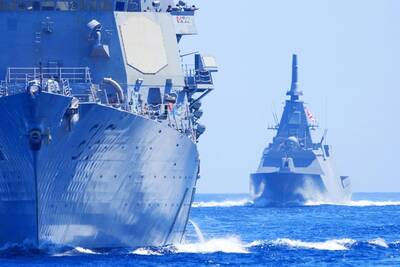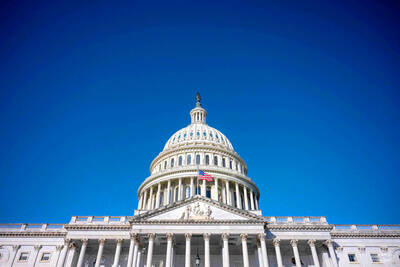Advanced Micro Devices Inc, Intel Corp's main rival in computer processors and flash memory chips, may ally with a Taiwan company to help build a chip factory that could cost as much as US$4 billion, local media reported yesterday.
The report, which did not cite sources, said AMD may join either Taiwan Semiconductor Manufacturing Co (
AMD announced Tuesday that it is looking for joint venture partners in the company's third 12-inch silicon wafer plant, expected to start operating in 2004.
Taiwan Semiconductor spokesman Tzeng Jing-hao (曾晉皓) declined to comment on whether his company is in talks about the project.
TSMC, the world's largest made-to-order semiconductor company, is one of a few chipmakers to start producing 12-inch wafers.
UMC spokesman Alex Hinnawi said he was unaware of any negotiations with AMD. UMC last month announced a joint venture with Infineon Technologies AG, Germany's largest chipmaker, for a 12-inch wafer plant to be built in Singapore for US$3.6 billion.
AMD President Hector Ruiz said Tuesday the company is looking for partners to build a 12-inch silicon wafer factory for US$4 billion. TSMC and UMC are among the first companies in the world to start production of 12-inch silicon wafers.
AMD snapped up more sales last year as No. 1 chipmaker Intel stumbled with chip shortages and technical glitches. AMD's flagship Athlon processors were the fastest chips available for much of the past year.
After its success in the consumer market, AMD plans to introduce chips for notebook and server computers that run Web sites. That means AMD will need more capacity, company spokesman John Greenagel said.
The processor plant, dubbed Fab 35, would be AMD's third.
The Sunnyvale, California-based chipmaker has one in Austin, Texas, and another in Dresden, Germany. AMD also has a joint venture with Fujitsu Ltd to make flash memory chips and said in July that the venture could begin adding a 12-inch wafer plant in 2002.
Chipmakers need to find partners to share the multi-billion dollar cost of building a 12-inch silicon wafer factory, said Janardan Menon, an analyst with Dresdner Kleinwort Wasserstein.
"AMD would be a better partner than Infineon [which joined in a plant project with UMC]," said Menon.
While TSMC and UMC both count processor makers Intel and AMD as customers, the Taiwan companies are only making chipsets for the two US companies, he said. Chipsets, which link a processor with other parts of a computer, don't require the most advanced manufacturing technology to produce.

NEXT GENERATION: The four plants in the Central Taiwan Science Park, designated Fab 25, would consist of four 1.4-nanometer wafer manufacturing plants, TSMC said Taiwan Semiconductor Manufacturing Co (TSMC, 台積電) plans to begin construction of four new plants later this year, with the aim to officially launch production of 2-nanometer semiconductor wafers by late 2028, Central Taiwan Science Park Bureau director-general Hsu Maw-shin (許茂新) said. Hsu made the announcement at an event on Friday evening celebrating the Central Taiwan Science Park’s 22nd anniversary. The second phase of the park’s expansion would commence with the initial construction of water detention ponds and other structures aimed at soil and water conservation, Hsu said. TSMC has officially leased the land, with the Central Taiwan Science Park having handed over the

The Philippines is working behind the scenes to enhance its defensive cooperation with Taiwan, the Washington Post said in a report published on Monday. “It would be hiding from the obvious to say that Taiwan’s security will not affect us,” Philippine Secretary of National Defense Gilbert Teodoro Jr told the paper in an interview on Thursday last week. Although there has been no formal change to the Philippines’ diplomatic stance on recognizing Taiwan, Manila is increasingly concerned about Chinese encroachment in the South China Sea, the report said. The number of Chinese vessels in the seas around the Philippines, as well as Chinese

AUKUS: The Australian Ambassador to the US said his country is working with the Pentagon and he is confident that submarine issues will be resolved Australian Ambassador to the US Kevin Rudd on Friday said that if Taiwan were to fall to China’s occupation, it would unleash China’s military capacities and capabilities more broadly. He also said his country is working with the Pentagon on the US Department of Defense’s review of the AUKUS submarine project and is confident that all issues raised will be resolved. Rudd, who served as Australian prime minister from 2007 to 2010 and for three months in 2013, made the remarks at the Aspen Security Forum in Colorado and stressed the longstanding US-Australia alliance and his close relationship with the US Undersecretary

‘WORLD WAR III’: Republican Representative Marjorie Taylor Greene said the aid would inflame tensions, but her amendment was rejected 421 votes against six The US House of Representatives on Friday passed the Department of Defense Appropriations Act for fiscal 2026, which includes US$500 million for Taiwan. The bill, which totals US$831.5 billion in discretionary spending, passed in a 221-209 vote. According to the bill, the funds for Taiwan would be administered by the US Defense Security Cooperation Agency and would remain available through Sept. 30, 2027, for the Taiwan Security Cooperation Initiative. The legislation authorizes the US Secretary of Defense, with the agreement of the US Secretary of State, to use the funds to assist Taiwan in procuring defense articles and services, and military training. Republican Representative